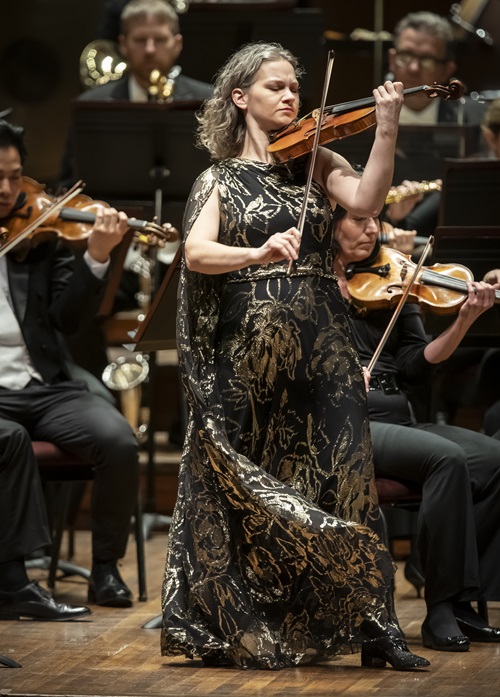NSO, Hahn preview Europe trip with polished Korngold, Beethoven

Hilary Hahn performed Korngold’s Violin Concerto with the National Symphony Orchestra Wednesday night. Photo: Scott Suchman
The National Symphony Orchestra leaves next week for a ten-concert European tour, from February 16 to 28. The final pieces of the tour programming slotted into place Wednesday night in the Kennedy Center Concert Hall with violinist Hilary Hahn, who will co-star as soloist with Seong-Jin Cho during the trip. The normal Thursday night performance was shifted forward a day, because Gianandrea Noseda will lead the NSO in this same program Monday night at Carnegie Hall, but with James Ehnes as soloist, before the tour begins.
Noseda chose Alban Berg’s Three Pieces for String Orchestra as a concert opener to feature the NSO strings, whose violin sections he has particularly helped shape and improve over his tenure. Berg arranged the second, third, and fourth movements of his original Lyric Suite for string quartet, which heightened the effect of the music’s most climactic moments. Noseda’s interpretation mostly underplayed the work’s harsher, more dissonant traits, revealing the strings’ plusher side.
The first movement, marked Andante amoroso, sounded warm and tender, with some intimate solo moments from concertmaster Nurit Bar-Josef and the other string principals. The outer sections of the second movement minimized the discordant, scratching motifs that pile up in a crazy mass. This helped avoid the feeling of a Second Viennese School piece being included on the program as something like the brussel sprouts that justify the dessert to come later.
More recent research showed that the second movement’s jagged themes outlined the names of Berg and a paramour named Hanna Fuchs-Robettin. After a more coherent, even swooning middle section, the opening music is repeated backwards to form a palindrome structure. The percussive strikes that ended it the first time begin the retrograde, softening from col legno into lighter taps and finally to the sotto voce opening on the name themes, now heard in reverse.
Cellos and violas came to the fore in the opening of the third movement, leading a polyphonic exploration of a keening half-step motif. The title Lyric Suite alluded to Alexander Zemlinsky’s Lyric Symphony, which Berg quoted in the Molto Tranquillo middle section of the third movement. Principal second violinist Marissa Regni rose out of a glowing halo of sound on this melodic snippet, originally set by Zemlinsky to the words “Du bist mein Eigen, mein Eigen” (You are my own, my own).
The lush dissonant harmony of the Berg piece, forming a sort of bridge between Strauss and serialism, made an ingenious introduction to Korngold’s Violin Concerto. In a sense, Berg came from the same formative influences as Korngold, who brought 20th-century Viennese harmony and orchestration to his work as a film composer when he fled Austria for Hollywood in the 1930s.
Korngold reportedly swore off composing concert music until Hitler had been defeated, a self-imposed ban that came to an end in 1945 with this concerto. In all three movements, he took up themes from his own film scores, from the longing opening melody of the first movement, heard in Another Dawn with Kay Francis and Errol Flynn, to the swashbuckling tunes in the third movement from The Prince and the Pauper, featuring the twins Billy and Bobby March.
Hahn’s intonation was initially not quite in agreement with the orchestra in the first movement, although that improved by the time the cadenza came along. The American violinist excelled in the cadenza and the other fast-moving parts, with brilliant double-stops and flawless detaché passages. Her greatest strength, a ribbon of delicate tone spun out high on the E string, served her well in the slow movement, a sentimental Romance quoted from Anthony Adverse, starring Fredric March and Olivia de Havilland.
Hahn and the NSO both seemed to settle most firmly into the concerto in the finale, played with crisply defined athleticism by the soloist. Noseda kept the orchestra scaled to Hahn’s generally smaller sound, unleashing epic cinematic sweep only in the grand tutti moments. Hahn answered the extended ovations with a moment of serenity, the expressive Largo movement from Bach’s Solo Violin Sonata No. 3.
The last of the three symphonies the NSO will play on tour is Beethoven’s Third Symphony, given in alternation with Shostakovich’s Fifth and Schubert’s Ninth. The inclusion of the “Eroica” highlights the fact that Noseda and the NSO will release their box set of the complete Beethoven symphonies later this month, during the tour. Noseda’s interpretation of this vivid symphony seemed influenced by historically informed performance practice: fast tempos, defined articulations, and little to no rubato, with all the repeats scrupulously observed.
The first movement felt lithe and supple, a preference for the long line prevailing over the tendency to dwell on details of accents and metric displacements. The second movement moved rather quickly for a funeral march marked Adagio assai, but the military efficiency of the playing also prevented this lengthy slow movement from dragging.
Noseda’s almost manic approach foundered slightly in the third movement. Spritely playing in the Scherzo sections impressed, answered by the boisterous calls of the three horns in the trio section. At the tempo Noseda imposed, the woodwinds had some minor trouble in their response to the horns in the trio. The energy level did not flag in the last movement, making for a cleanly delivered finale, with especially defined and exuberant string playing.
The program will be repeated 7 p.m. Thursday and 8 p.m. Friday. kennedy-center.org

Posted Feb 09, 2024 at 12:33 pm by John L Dyer
Your reading public would benefit from lessons on how to appreciate 12 tone compositions. I cannot fathom how the 12 tone rule makes any sense, and certainly don’t believe it can result in music. The contrast between Alban’s noise and Erich’s and Ludwig’s music is my evidence of need for those lessons.
Posted Feb 10, 2024 at 3:31 pm by Robert Cohn
I am shocked with your critique of Hahn in Korngold and Noseda’s rendition of the Eroica. I attended the Thursday performance and it was uniformly superb. I cannot recall a recent concert where the audience (and the orchestra) was so enthusiastic about the performances.
I heard the Eroica last year in Philadelphia with Yannick conducting and I thought that was the most amazing performance until I heard Noseda’s– it was remarkable and superbly brought out inner voices, particularly the woodwinds. I could find no fault with his conducting. Just because you are a “critic” doesn’t mean you have to be “critical”.
The NSO is emerging as one of the country’s leading ensembles under Noseda.